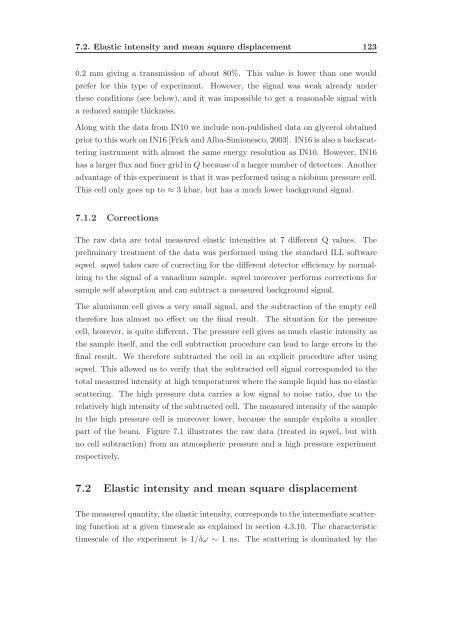Ph.D. thesis (pdf) - dirac
Ph.D. thesis (pdf) - dirac
Ph.D. thesis (pdf) - dirac
Create successful ePaper yourself
Turn your PDF publications into a flip-book with our unique Google optimized e-Paper software.
7.2. Elastic intensity and mean square displacement 123<br />
0.2 mm giving a transmission of about 80%. This value is lower than one would<br />
prefer for this type of experiment. However, the signal was weak already under<br />
these conditions (see below), and it was impossible to get a reasonable signal with<br />
a reduced sample thickness.<br />
Along with the data from IN10 we include non-published data on glycerol obtained<br />
prior to this work on IN16 [Frick and Alba-Simionesco, 2003]. IN16 is also a backscattering<br />
instrument with almost the same energy resolution as IN10. However, IN16<br />
has a larger flux and finer grid in Q because of a larger number of detectors. Another<br />
advantage of this experiment is that it was performed using a niobium pressure cell.<br />
This cell only goes up to ≈ 3 kbar, but has a much lower background signal.<br />
7.1.2 Corrections<br />
The raw data are total measured elastic intensities at 7 different Q values. The<br />
preliminary treatment of the data was performed using the standard ILL software<br />
sqwel. sqwel takes care of correcting for the different detector efficiency by normalizing<br />
to the signal of a vanadium sample. sqwel moreover performs corrections for<br />
sample self absorption and can subtract a measured background signal.<br />
The aluminum cell gives a very small signal, and the subtraction of the empty cell<br />
therefore has almost no effect on the final result. The situation for the pressure<br />
cell, however, is quite different. The pressure cell gives as much elastic intensity as<br />
the sample itself, and the cell subtraction procedure can lead to large errors in the<br />
final result. We therefore subtracted the cell in an explicit procedure after using<br />
sqwel. This allowed us to verify that the subtracted cell signal corresponded to the<br />
total measured intensity at high temperatures where the sample liquid has no elastic<br />
scattering. The high pressure data carries a low signal to noise ratio, due to the<br />
relatively high intensity of the subtracted cell. The measured intensity of the sample<br />
in the high pressure cell is moreover lower, because the sample exploits a smaller<br />
part of the beam. Figure 7.1 illustrates the raw data (treated in sqwel, but with<br />
no cell subtraction) from an atmospheric pressure and a high pressure experiment<br />
respectively.<br />
7.2 Elastic intensity and mean square displacement<br />
The measured quantity, the elastic intensity, corresponds to the intermediate scattering<br />
function at a given timescale as explained in section 4.3.10. The characteristic<br />
timescale of the experiment is 1/δω ∼ 1 ns. The scattering is dominated by the

















